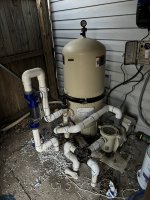- Apr 10, 2018
- 5,169
- Pool Size
- 18375
- Surface
- Plaster
- Chlorine
- Salt Water Generator
- SWG Type
- CircuPool RJ-45
The flow switch should be in horizontal pipe or a vertical pipe where water flows up. Yours is installed in a pipe where water flows down. If the flow switch were to fail, there would be no flow switch protection to turn the cell off.
Hook the pump up to the 'LINE' side and the SWG up to the 'LOAD' side. This will provide constant power to your VS pump and timed power to the SWG. Just set the time to run within the pump run times and check the time sync monthly and after any power outage.
I'd just start over with new unions and build my own vertical kit. (Much cheaper) The vert kit is really for first timers anyway, and this is your second time so you fully understand how it works and what parts to buy.
Here it is - this is my final answer. I went and got schedule 40 elbows and basically redid the whole dang thing this afternoon. Flow switch has approx 9 inches of straight pipe and is now on the upward flowing vertical pipe. Moved the cell to the other downward flowing pipe and removed all those funny steps from my original install.Also, be sure to use schedule 40 rated fittings.
Several of the 90* elbows appear to be DWV fittings - not pressure rated sched 40. DWV shouldn't be used here.

Definitely on my to-do list, just didn’t have any zip ties long enough to cover the circumference of the 2” pipe!Consider using reusable cable ties to better secure the SWG and flow switch wiring - especially to help prevent strain at the connection point on the cell and switch.
Checked with Circupool and they confirmed the orientation of the cell does not matter in terms of flow.Also, maybe check with Circupool about orientating the SWG with the cable at the bottom. I'm not sure if flow direction is important with the Circupool cell, since the flow switch is separate from the cell.
When attaching the wires to the pipe, consider routing the wire on the bottom of the pipe to minimize sun/weather exposure.Definitely on my to-do list, just didn’t have any zip ties long enough to cover the circumference of the 2” pipe!
Checked with Circupool and they confirmed the orientation of the cell does not matter in terms of flow.
Thank you all for your help!
Does the above account for initial salt loading the pool, the additions of salt to pool as needed, or the electricity use in running the SWG?I can promise you that if somebody understood their system and their chemistry, they loved them.
SWGs are often sold as hands off, to people who never learned their systems or the chemistry, and those are the disasters you hear about.
To figure out your ROI, it's pretty simple. For 26k gallons, each gallon of 10% chlorine nets you 3.84 FC. Here is your FC cost for the gallon prices you will likely see this season.
$5 gallon = $1.30 per FC
$6 gallon = $1.56 per FC
$7 gallon = $1.82 per FC
Narrow down your SWG choices and find it's production of chlorine per 24 hours in poolmath. A 10k hour lifespan unit equals 417 days of straight production. Multiply the daily production by 417 to get your total lifespan FC produced. (In perfect conditions).
Take the cost of the SWG, controller and install costs if applicable and divide that by the lifespan FC for your cost per FC.
So let's take a Pentair IC60 system going for $1600 today. It produces 9.2 FC a day in 26k gallons, or 3836 lifetime FC.
$1600 system = $0.42 per FC which is about 1/3 the cost of the cheapest gallon of bleach for sale right now. In theory, over its lifespan, the unit will be 3 times cheaper than LC for you. If the price spikes this afternoon to $1900, it will cost $0.50 per FC.
*installation costs if you don't DIY will take away some savings. If installation doubles the cost to $3200, you'll still save some on the first unit, but the future units will be the big paybacks.
*the $569 controller usually lasts 3 cells so the next two replacements only need the $1100 cell, basically covering your installation costs, and if you DIY'd it, the replacement units will really pay off
$1100 unit = $0.28 per FC.
^^^^^^ all this said, I would pay 3X the liquid chlorine price for the convenience the SWG provides. That 'payback' is literally priceless. I spent 20 mins total on FC monitoring/adjusting from June to mid November. That includes getting the kit out, going out to get a water sample, and putting the kit away. My FC stayed at high target or above and the thought of algae never entered my mind. *And* it saved me 2 or 3 times what the LC would have cost, not including time and effort.
No. But 40 lb bags of salt are cheap ($10 ish each these days) and even with a large pool I will be under $100 for the season.Does the above account for initial salt loading the pool, the additions of salt to pool as needed, or the electricity use in running the SWG?
yep.$9. that’s whatci’ve found.Thanks so much for everyone's responses! I am a relatively competent DIYer, but have never tried doing anything with the pool. does anyone have good resources on a step by step for installation? I do well with videos, but clarity in that medium is often an issue for most videos.
Try $9 a gallon at Home Depot / Lowes!

